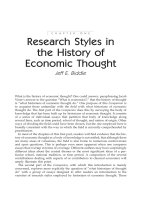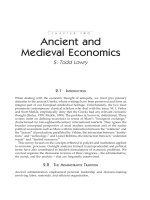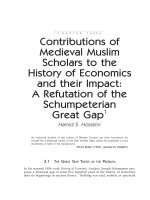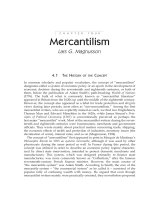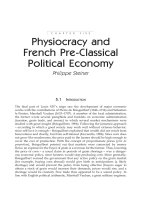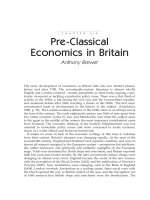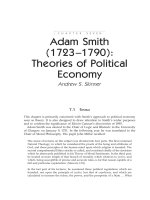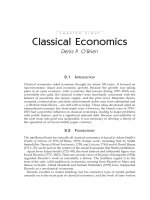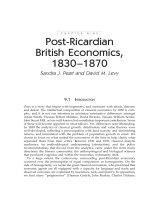A Companion to the History of Economic Thought - Chapter 26 pptx
Bạn đang xem bản rút gọn của tài liệu. Xem và tải ngay bản đầy đủ của tài liệu tại đây (216.11 KB, 17 trang )
A HISTORY OF POSTWAR MONETARY ECONOMICS AND MACROECONOMICS 411
CHAPTER TWENTY- SIX
A History of Postwar
Monetary Economics
and Macroeconomics
Kevin D. Hoover
26.1 WORLD WAR II AS A TRANSITIONAL PERIOD
Despite a degree of arbitrariness, World War II provides a natural division in the
history of macroeconomics. The macroeconomics of the interwar period was a rich
tapestry of competing models and methodologies, pursued with a sophistication
that was only gradually regained in the postwar period (see chs. 19 and 20; Laidler,
1999). John Maynard Keynes’s The General Theory of Employment, Interest and Money,
published in 1936, three years before the onset of war in Europe, appeared to
many as an important, but not preeminent, contribution to the contemporary
debates. Yet, by 1945, Keynesian macroeconomics was clearly ascendant.
Keynes provided a conceptual framework that greatly simplified professional
discussions of macroeconomic policy. The main elements were: (i) an aggregat-
ive analysis – his key distinction between the economics of individual or firm
decision-making, taking aggregate output as fixed, and the economics of output
and employment as a whole supplies the content, if the not the name, of the
now common distinction between microeconomics and macroeconomics; (ii) the
determination of aggregate output by aggregate analogues to Marshallian supply
and demand; (iii) the possibility (even likelihood) that aggregate supply and
demand could determine a level of output at which resources were not fully
employed; and (iv) the possibility that monetary and fiscal policies could boost
aggregate demand to counteract unemployment.
The decade after the publication of The General Theory was a period of explora-
tion, investigation, and consolidation – a period in which the Keynesian model
412 K. D. HOOVER
was forged into the paradigm that guided mainstream macroeconomic analysis
for the next three decades. John Hick’s (1937) IS–LL model (later renamed the
IS–LM model) emerged as the canonical representation of the Keynesian sys-
tem. The downward-sloping IS curve represented combinations of interest rates
and output for which planned savings (directly related to income or output) and
planned investment (inversely related to interest rates) were equal. The upward-
sloping LM curve represented combinations in which the demand for money
(directly related to income and inversely related to interest rates) equaled the
fixed supply of money. The crossing point determined the level of aggregate
demand. Hicks placed little stress on aggregate supply, while Modigliani’s (1944)
influential Keynesian model offered a highly simplified aggregate-supply curve:
perfectly elastic at the current price level up to full employment and inelastic at
full employment – a reverse L-shaped curve in price/output space.
These models simplified Keynes’s account in an effort to render it into a closed
set of algebraic equations. They represented the core structure of The General
Theory, but omitted many nuances. Alan Coddington (1983) stigmatized them –
with some justice – as “hydraulic Keynesianism.” What it lost in detail, hydraulic
Keynesianism made up in its suitability for mathematical and structural eco-
nometric elaboration.
The war itself gave a boost to practical Keynesianism. Keynes had diagnosed
the Great Depression of the 1930s as a massive failure of aggregate demand. The
war represented an enormous boost to aggregate demand that finally ended the
Depression and led governments to accept the legitimacy of deliberate inter-
ventions to direct the economy. The Beveridge Report of 1942 in Great Britain
and the Employment Act of 1946 in the United States provided blueprints
for government involvement in the macroeconomy along Keynesian lines. The
war was financed through massive government borrowing. After previous wars,
governments had generally placed a high priority on the repayment of these
debts. This time, however, Abba Lerner’s (1943) Keynesian notion of “functional
finance” suggested that government fiscal policy should be judged for its effects
on output, employment, and prices, rather than on accounting standards in which
the balanced budget held a special place. Policy-makers were concerned that
demobilization of the millions of men and women under arms could trigger a
postwar recession, and they were prepared to respond with demand stimulus.
Practical policy required good information on the state of the economy. Keynes’s
aggregative framework fitted well with the design of systematic national ac-
counts due to Colin Clark, Simon Kuznets, and Meade and Stone. The collection
of macroeconomic data accelerated rapidly after the war in most developed
countries, which proved a boon for scientific research in macroeconomics as well
as for practical policy-making.
26.2 THE ERA OF KEYNESIAN DOMINANCE, 1945–1970
For at least 25 years after the end of World War II, mainstream macroeconomics
was predominantly Keynesian. The General Theory had collapsed the rich debates
A HISTORY OF POSTWAR MONETARY ECONOMICS AND MACROECONOMICS 413
of the 1920s and 1930s into a static, short-run, aggregative model, concerned
exclusively with a closed economy. One central plank on the agenda for macro-
economic research was to recover what was lost in Keynes’s simplifications. A
second was to use the newly available data sources to give empirical content to
ever more detailed Keynesian models. A third was to explore the relationships
between the now distinct categories of macroeconomics and microeconomics.
26.2.1 Long-run growth
Fluctuations in investment were the key to Keynes’s analysis of aggregate
demand and the business cycle, yet The General Theory contains no systematic
account of its role in economic growth. To repair this omission, Roy Harrod,
beginning in 1939, developed a theory in which labor and capital combined in
fixed proportions to generate output.
Ignoring technical progress, the growth rate of the economy depended on
the investment rate (misleadingly referred to as the savings rate) and the rate
at which capital was converted into output. Harrod defined the warranted rate
of growth as g = s/v = investment share in GDP/capital-output ratio. He defined
the natural rate of growth as the rate of growth of the labor force (n). So long as
g = n, the economy will grow steadily. Evsey Domar independently constructed
essentially the same model. The Harrod–Domar model displays “knife-edge”
instability. If s is low enough, so that g < n, then unemployment in the economy
will rise progressively; if it is great enough, any existing unemployment will be
absorbed and, with no further labor available, the growth in output will be
stymied.
Working independently, Robert Solow and Trevor Swan suggested in 1956
that the knife-edge property of the Harrod–Domar model resulted from the
assumption of fixed technology (constant v). If firms could adjust their inputs to
reflect relative factor prices, then progressively increasing unemployment, for
example, would result in a falling real wage and a fall in the capital-output ratio,
raising g and reestablishing a balanced or steady-state growth path at the natural
rate (n).
The Solow–Swan (or neoclassical growth) model was easily adapted to include
technical progress treated as a rescaling of its underlying constant-returns-to-
scale production function. It formed the basis for Solow’s accounting exercise in
which the sources of US GNP growth were attributed to growth in the factors of
production and to technical progress (total factor productivity). His conclusion
that total factor productivity was overwhelmingly the dominant factor seemed
to many to be counterintuitive. By the early 1960s, intellectual effort focused
on developing the model, including adding endogenous technical progress,
embodied in a capital stock differentiated by investment vintage, and extending
it to multiple sectors. (For a contemporaneous survey of the growth literature,
see Hahn and Matthews, 1964.)
Joan Robinson, Nicholas Kaldor, and other economists at the University of
Cambridge (England) developed accounts of growth that were closely related to
Harrod’s and skeptical of the neoclassical approach. They tried to integrate the
414 K. D. HOOVER
Keynesian demand model and a Marxist or neo-Ricardian account of income
distribution. Robinson, in particular, criticized the aggregate neoclassical, margin-
alist theory of distribution in which profits were the marginal product of capital.
While the marginal analysis might work for a particular, homogeneous physical
capital good and a single firm, aggregate capital was measured in monetary
terms: the sum of the present discounted value of the expected profit streams of
the physical means of production of all firms. The quantity and price (the rate
of discount) of aggregate capital must be jointly determined. Aggregate capital
was not, then, the sort of independent quantity that could have a well-defined
marginal product, which in turn determined its rate of return. Robinson main-
tained that the very notion of aggregate capital was circular and absurd.
In the debate that came to be known as the “Two Cambridges Controversy,”
Paul Samuelson, Solow, and other economists associated with the Massachusetts
Institute of Technology in Cambridge, Massachusetts, essentially conceded
Robinson’s point. Nonetheless, they maintained that, as an idealization or
“parable,” the distributional consequences of the Solow–Swan (or neoclassical)
growth model pointed robustly in the right direction. Cambridge, England, won
the debate on a technicality, demonstrating, that with heterogeneous physical
capital goods, it was possible that there would not be a monotonic inverse rela-
tionship between wage and profit rates as predicted by the neoclassical parable.
Cambridge, Massachusetts, however, won the larger battle: aggregate capital,
aggregate production functions, and the Solow–Swan model remain workhorses
of mainstream macroeconomics to this day (see Harcourt, 1972; Bliss, 1975).
The Solow–Swan model provided a framework for the analysis of long-run
policy. The first efforts of Edmund Phelps and others took the maximization of
consumption per head to be the policy goal. The so-called “golden rule” for
growth called for investment policies that resulted in a rate of return on capital
equal to the sum of the rate of growth of the labor force, the rate of technical
progress, and the rate of depreciation. The analysis warned against overinvestment:
capital–labor ratios higher than the golden rule level were inefficient in the com-
parative static sense that a lower level supported a higher consumption per head;
and also in the dynamic, or Paretian, sense that movement toward the golden
rule would free up capital for consumption and would permit higher consump-
tion per head in every period along the transition to the golden-rule balanced-
growth path. Because investment rates below the golden rule are dynamically
efficient and not Pareto-rankable, growth theory from the mid-1960s on stressed
optimal-growth models in which preferences over intertemporal consumption
patterns are reflected in an aggregate utility function. Essentially, the investment
rate (s) was treated as an endogenous variable rather than a given parameter.
In another extension, Robert Mundell and James Tobin incorporated money
demand functions into the neoclassical growth model. The “Tobin–Mundell
effect” in their models violates superneutrality: inflation raises the opportunity
cost of holding money and encourages substitution into real capital, boosting
output. In contrast, Miguel Sidrauski’s monetary model, which introduces real
money holdings into the utility function of an optimal-growth model, preserves
superneutrality.
A HISTORY OF POSTWAR MONETARY ECONOMICS AND MACROECONOMICS 415
To this day, the optimal growth model forms the core of the account of
long-run dynamics in mainstream macroeconomics – and is widely accepted by
economists who disagree extensively over short-run and policy issues. By 1970,
research into growth models had reached diminishing returns, and little advance
was made until the advent of endogenous growth models in the work of Paul
Romer and Robert Lucas, in the mid-1980s. These models widened the scope
of macroeconomics to address important questions in economic development,
but have little affected the larger course of macroeconomics. (For further refer-
ences on growth, see Wan, 1971; Jones, 1998.)
26.2.2 Short-run dynamics
Interwar macroeconomics had included elaborate accounts of the short-run
dynamics of the business cycle, but The General Theory offered only a static
model. Substantial postwar research reintroduced dynamical features into every
aspect of the Keynesian model. The two most significant areas, perhaps, were
dynamical accounts of inflation and unemployment.
He was not the first to discern an inverse relationship between wage inflation
and unemployment, but A. W. H. Phillips’s (1958) study of nearly 100 years of
data for the United Kingdom proved to be a landmark. Phillips’s study was
grounded in a vision of the Keynesian model as a system developing in real time
and in Phillips’s own research into the mathematics of optimal control. Unlike
Keynes, Phillips modeled firms as wage-setters. In light of later developments,
it is also worth noting that Phillips was careful to account for the role of
trend inflation in such a way that he respected the distinction between real and
nominal wages.
Development of the Phillips curve proceeded on three tracks. First, by the
early 1960s Phillips curves were estimated for many countries, using both wage
inflation and price inflation as dependent variables. Secondly, a number of eco-
nomists, most notably Richard Lipsey, elucidated the microeconomic behavior
that might account for the Phillips curve. And, thirdly, Paul Samuelson and
Solow provided an analysis that treated the Phillips curve as a menu of policy
choices in which higher inflation was the price of lower unemployment. Their
notion of an exploitable tradeoff helped to place the Phillips curve in the
center of practical policy analysis. Again, in light of later developments, it is
worth noting that Samuelson and Solow were aware that the overly aggressive
exploitation of the tradeoff might lead to an acceleration of trend inflation and an
unfavorable shift of the tradeoff itself (see Wulwick, 1987).
By the beginning of the Kennedy Administration, Keynesian economic
advisors dominated American government circles. One advisor, Arthur Okun,
answered the question of how to guide aggregate-demand management with
another empirical relationship. “Okun’s Law” states that there is an approx-
imately linear, inverse relationship between the growth of output and changes
in the unemployment rate. Okun’s Law has not received extensive theoretical
investigation or development, but has remained an important rule of thumb for
policy-makers.
416 K. D. HOOVER
26.2.3 Macroeconometric models
Structural macroeconometric modeling began before World War II (Tinbergen,
1939). Although Keynes was deeply skeptical of the econometric enterprise, the
model-builders quickly incorporated the Keynesian framework. Nearly every
postwar model is an elaboration on the simple IS–LM/aggregate-supply frame-
work. In part, this is a testament to the flexibility and breadth of that framework
and, in part, a reflection of the mutual adaptation of the Keynesian model and
the national-accounting conventions that governed data collection.
The pivotal figure in the history of econometric model-building was Lawrence
Klein, a close student of The General Theory. Klein took advantage of recent devel-
opments in structural econometrics due to Trygve Haavelmo and the Cowles
Commission. Building on Tinbergen’s work, by 1950 Klein formulated and esti-
mated three models of the interwar US economy. Working with Arthur Goldberger,
Klein developed a seminal model of the postwar US economy in 1955, a model
with 20 stochastic equations and five identities that was used for forecasting and
policy analysis. Meanwhile, Tinbergen supervised the creation of a series of
increasingly sophisticated models of the Dutch economy. Working with a group
at Oxford University, Klein developed a model for the UK economy. (For the
early history of macroeconometrics, see Morgan, 1990; Hendry and Morgan, 1995.)
Macroeconometric model-building and its supporting activities (see section
26.2.4) dominated macroeconomic research in the 1960s. In both the USA and the
UK, researchers continued to elaborate Klein’s model. Three models represent
pinnacles of American model-building in the late 1960s. The largest was the Social
Science Research Council (SSRC)/Brookings model, which ultimately included
about 400 stochastic equations. The MPS (Massachusetts Institute of Technology/
University of Pennsylvania/SSRC) model was similar to the Brookings model,
but included a rich financial sector. Finally, the Data Resources Incorporated
(DRI) model – similar in scope to the other large models – was the most important
commercial macroeconometric model. DRI found a significant market for model-
based forecasts and policy analysis, as well as for the macroeconomic database
that it maintained to support its model. By the early 1970s, macroeconometric
models had been constructed for virtually all developed, and for many developing,
countries (see Bodkin, Klein, and Marwah, 1991).
26.2.4 Microfoundations of macroeconomics:
individual equations
In The General Theory, Keynes rationalized the key aggregate relationships such
as the consumption function and the investment function with reference to
individual behavior. In The Keynesian Revolution (1947), Klein emphasized the
desirability of securing the microfoundational underpinnings of each of these
functions. A reciprocal effort to develop the econometrics of individual equations
of the large macromodels and their theoretical, microeconomic underpinnings
was a substantial focus of research in this period.
A HISTORY OF POSTWAR MONETARY ECONOMICS AND MACROECONOMICS 417
The consumption function presents the clearest case. Keynes had admitted a
large number of potential factors into the analysis of consumption and savings.
These included precaution, bequests, time preference, considerations of expected,
or life-cycle, income and consumption patterns, capital gains and losses, fiscal
policy, expectations, and the average level of real wages (consumption and
income were measured in wage units). But early attempts to model consumption
empirically assumed that the static consumption was linear in disposable income
and that the marginal propensity to consume was less than the average prop-
ensity to consume. This implied that over time – as the economy became richer
– the average propensity to consume should be falling, and that cross-sectionally
richer people should have a lower average propensity to consume than poorer
people. Research by Simon Kuznets suggested that, while these implications might
be true in the short run and cross-sectionally, in the long run (decade to decade)
the marginal propensity to consume and the average propensity to consume
were equal and approximately constant.
James Duesenberry (1949) reconciled the long-run time series with (i) the short-
run time series and (ii) the cross-sectional data by modeling consumption as a
function of individuals’ past incomes and those of their social group. As income
rises over time, individuals reset their standard of prosperity and so, on average,
do not come to regard themselves as high income unless their income rises faster
than those of their social peers. Despite the empirical evidence that he offered,
the economics profession viewed Duesenberry’s “relative-income hypothesis” as
unsatisfactory because of its appeal to sociological facts that were not accounted
for as the outcome of an explicit individual optimization problem. Building on
joint work with Kuznets, Milton Friedman (1957) modeled consumption as an
intertemporal optimization problem in which the budget constraint was the
implicit return on the present value of all future income (labor and nonlabor).
Almost simultaneously, Franco Modigliani and Richard Brumberg (1954) modeled
consumption in a nearly equivalent manner, focusing on the stock of implicit
wealth rather than the flow of income from the same present-value calculation.
On the assumption that people prefer consumption streams that are steadier
than their income streams, the “permanent-income/life-cycle model” suggests
that Kuznets’s puzzles result from mismeasurement. The average and marginal
propensities to consume from permanent income are equal and constant. Trans-
itory fluctuations in income little change permanent income or consumption.
Permanent income is not directly observed, as it depends on individuals’ expec-
tations of future income. The responsiveness of consumption to measured income
is lower in the short run since transitory components dominate, and higher in
the long run when they tend to cancel out. Similarly, in the cross-section, some
observed individuals experience transitory income higher (lower) than their
permanent income and so have lower (higher) consumption than individuals
with permanently high (low) income. Thus, the measured marginal propensity
to consume is lower than the permanent marginal and average propensity to
consume that is observable in the long-run time series.
Friedman’s investigation of the consumption function also revived interest
in the role of expectations, largely ignored since Keynes’s The General Theory.
418 K. D. HOOVER
Friedman’s method of modeling expectations of future income through a geo-
metrically weighted sum of past incomes proved easy to rationalize as partial
adjustment to past prediction errors and was widely applied in other contexts.
Other constituent functions of the Keynesian macromodel received similar treat-
ment in the 1950s and 1960s. William Baumol and Tobin, for instance, modeled the
transactions and speculative demands for money (Laidler, 1993), while Dale
Jorgenson, among others, modeled the microfoundations of investment.
Research into the microfoundations of individual relationships derived much
of its cachet from its relation to research into large-scale macromodels. Both
were driven from center stage with the emergence of general equilibrium micro-
foundations as the dominant research program in macroeconomics, although
they remain of considerable practical interest to this day.
26.2.5 Microfoundations of macroeconomics:
general equilibrium
One of Keynes’s main criticisms of the “classics” was their failure to account
for the interdependence of production and consumption decisions. He offered
instead an aggregate general equilibrium system. The IS–LM model reinforced
the general equilibrium nature of the Keynesian model. Nevertheless, beginning
with Wassily Leontief’s early critique of The General Theory, many economists
questioned the consistency of the Keynesian model with the microeconomic
general equilibrium model.
Don Patinkin addressed the two main problems in his Money, Interest, and
Prices (1956). First, the standard Walrasian general equilibrium model is essen-
tially a barter model. Walras had introduced money through an aggregate
relationship similar to a standard quantity-equation for money, but this did not
account for the individual behavior of money holders in a manner analogous
to other supply and demand relationships in the model. Patinkin argued that
money was held for its services and should be valued like other real goods.
Patinkin entered real money balances (M/p) into the individual utility functions
of an otherwise Walrasian model. Patinkin wrote nearly simultaneously with the
publication of the proofs of the existence of a general equilibrium in systems
without money. He assumed – but did not prove – the existence of an equilib-
rium with money. Frank Hahn later showed that, in general, there is no solution
to Patinkin’s system, because the price deflator can change discontinuously as
relative prices adjust in the tâtonnement process through which equilibrium is
established. Patinkin’s solution has remained influential at an aggregate level,
but was unsuccessful in providing true microfoundations (see Hoover, 1988).
Patinkin also isolated the second problem: the Walrasian system assumes that
quantities adjust to prices under the assumption that no trades are made until a
market-clearing price vector is established, yet the Keynesian model assumes
that quantities respond to quantities (e.g., the consumption function relates
consumption to income, not to prices) or that markets do not clear. Patinkin
examined the labor market closely in light of these problems. They were taken up
A HISTORY OF POSTWAR MONETARY ECONOMICS AND MACROECONOMICS 419
in more generality by Clower (1965). He argued that, if producers and consumers
knew that markets would not clear, they would incorporate quantity constraints
into their decisions. For example, a worker who knew that he could not purchase
as many goods as he liked at the current price would supply less labor at a given
real wage than he would if the goods supply were infinitely elastic at that price.
Clower argued that prices are often set away from their market-clearing values,
so that quantity rationing is the norm. Ubiquitous rationing accounts for such
Keynesian relationships as the consumption function and the aggregate-supply
function. Axel Leijonhufvud (1968) constructed an elaborate historical reinter-
pretation of Keynes’s The General Theory on the basis of Clower’s analysis.
Robert Barro and Herschel Grossman (1971) provided the most influential
formal model of Clower’s analysis. They simplified the analysis by assuming that
prices were fixed by forces outside the model. Their “fixed-priced” model is
notable for importing the representative-agent approach from growth theory.
With no serious account of how to construct economy-wide aggregates from the
choices of individual agents, this move was a serious retreat from the original
goal of the microfoundational program. Although the fixed-price model was
quickly supplanted in the United States, it became highly developed in Europe
(e.g., Malinvaud, 1977) and remains influential.
26.3 THE DEBATE OVER MONEY AND MONETARY POLICY,
1956–1982
26.3.1 Diminishing the importance of money
Although the title of Keynes’s masterwork included Money and Interest, early
postwar Keynesians emphasized fiscal policy over monetary policy. Although
not accurate as exegesis, Hicks (1937) famously justified his judgment that “the
General Theory of Employment is the Economics of Depression” by the “special
form of Mr. Keynes’s theory” in which the LM curve is infinitely elastic (later
referred to as the “liquidity trap”). Empirical research in prewar Britain also
suggested that the investment function and, hence, the IS curve were nearly
interest-inelastic. A horizontal LM curve and a vertical IS curve together imply
impotent monetary policy.
As well as underwriting the weakness of monetary policy, the Radcliffe Report
to the British Parliament (1959) argued that the existence of numerous close
substitutes for currency and checking accounts implied that the velocity of circu-
lation for any narrow monetary aggregate would be highly unstable, rendering it
both hard to define a practicable concept of money and to control the real economy
with any particular monetary aggregate. The report advocated targeting interest
rates as the only practical monetary policy.
The Radcliffe Report reflected the “new view” of money. John Gurley and Edwin
Shaw (1960) and Tobin, among others, advocated replacing the simple money/
bond dichotomy of the Keynesian system with a fuller account of the wide spec-
trum of financial assets. Tobin (1969) especially tried to link the financial system
420 K. D. HOOVER
to the real economy through a variant on an idea of Keynes’s that is often referred
to as “Tobin’s q”: the ratio of the market value of a real asset to its replacement
cost. When q is greater than unity, it pays to invest; when it is less than unity, it
is better to hold financial assets. Working with William Brainard, Tobin engaged
in a heroic attempt to adapt the new view to the econometric macromodel.
26.3.2 Emphasizing the importance of money
The University of Chicago was relatively immune to Keynesian ideas and, through
the 1930s and 1940s, continued to teach the classical quantity theory of money,
despite Keynes’s criticisms. Milton Friedman reinvigorated the Chicago tradition
in an edited volume, Studies in the Quantity Theory of Money (1956), and, especially,
in his own contribution to it, “The quantity theory: a restatement.” Rather than
Irving Fisher’s transaction version of the quantity theory, Friedman adopted the
“Cambridge” or income version which, given the existence of national-income
accounts, proved easier to implement empirically. In itself, Friedman’s demand
function for money is perfectly compatible with Keynesian analysis. The differ-
ences between Friedman and the Keynesians center on his insistence that: (i)
markets clear in the long run; (ii) the demand for money is a stable function of a
few variables, even if the unconditional velocity of circulation is highly variable;
and (iii) the supply of money is easily controllable by the monetary authorities.
The quantity of money is unimportant for real outcomes in the long run as
markets clear, but most short-run cyclical real fluctuations can be blamed on
bungled monetary policy.
Friedman and his colleague Anna Schwartz won many converts to their view that
monetary policy is the principal cause of cyclical fluctuations with the magisterial
Monetary History of the United States (1963). The tour de force was their account of
the Great Depression as an unintended monetary contraction. Peter Temin (1976)
argued that this explanation required that interest rates rise along with falling
output, but that, in fact, interest rates fell. While no one Keynesian offered a
complete reassessment of US monetary history, the debate in the 1960s was highly
empirical, focusing on the stability of money demand compared to the stability
of Keynesian multipliers, the predictive power of monetary policy compared to
fiscal policy, and the independent controllability of the money supply. These
heated debates often hinged on what counted as acceptable econometric methods
and, in a climactic battle over the causal direction between money, on the one
side, and output and prices, on the other, became intensively methodological.
26.3.3 Monetarism
In the end, the war was fought to a draw in the sense that neither side won many
converts. Yet, under the sobriquet monetarists, the quantity theorists did establish
themselves as an intellectually formidable alternative to the previously dominant
Keynesians.
The monetarist assumption of the long-run neutrality of money stood in direct
conflict to a long-run tradeoff between inflation and unemployment implied by a
A HISTORY OF POSTWAR MONETARY ECONOMICS AND MACROECONOMICS 421
simple Phillips curve. In 1967 Edmund Phelps developed a model in which the
Phillips curve emerged in an expectations-augmented form: aggregate demand
stimulus accelerated inflation, but reduced unemployment only until expecta-
tions adapted to the new policy. Independently, in his presidential address to the
American Economic Association that same year, Friedman argued that monetary
policy could affect real output only in the short run. In the long run, the Phillips
curve was vertical at a “natural rate of unemployment” determined by tastes,
technology, resources, and institutions. The natural-rate hypothesis received a
strong boost when, in the early 1970s, inflation and unemployment rose simul-
taneously in most developed economies.
Adopting an old Chicago theme due to Henry Simons, Friedman and other
monetarists, such as Karl Brunner and Allan Meltzer, advocated that monetary
policy be conducted according to simple, fixed rules. The rationale was partly
libertarian (the government should not manipulate people’s behavior), partly
based in the Phillips curve (expectations are more accurately formed when policy
is easily understood), and partly an expression of distrust in econometric models
(the lags between monetary actions and their real effects are long, variable,
and poorly modeled, and attempting to exploit them often leads to perverse out-
comes). Monetarists preferred a rule that targets a relatively narrow monetary
aggregate (the monetary base, or “M1”). Market interest-rate rules would, they
argued, be unstable: if the target were too low, inflation would increase, cutting
real interest rates and further increasing inflation.
Although much has been made over the differences between monetarists and
Keynesians (see Mayer, 1978), monetarists were at ease with Keynes’s highly
aggregated framework and showed little interest in the effort to develop general
equilibrium microfoundations. Mainstream Keynesians easily adopted the idea
of the natural rate or – as many preferred to call it – the nonaccelerating inflation
rate of unemployment (NAIRU). The most important differences were (i) whether
deviations from the natural rate – logically, belonging to the Marshallian short-
run – in practice lasted a short time (as the monetarists thought) or a long time
(as the Keynesians thought) and (ii) whether aggregate-demand policy could
reliably and effectively offset these deviations.
Monetarism influenced – and continues to influence – central banks around the
world. Especially important are the monetarist notions that monetary policy can
effectively target only nominal quantities and, therefore, ought to target inflation,
and that central banks should be independent of political control and follow
transparent rules. Beyond this, a strict monetarism was attempted in the US only
for a brief time between 1979 and 1982, as a response to high and accelerating
inflation. The experiment collapsed as a result of the instability of the link
between the target variable (the monetary base) and the money stock (M1) and
the instability of the demand for money in the face of financial innovation (Judd
and Scadding, 1982). While advocating some monetarist principles, the Federal
Reserve resumed interest-rate targeting in 1982.
During Margaret Thatcher’s premiership, monetarism became highly influen-
tial (and hotly contested) in the United Kingdom. In a paper that was circulated
in British policy circles long before its publication, David Hendry and Neil Ericsson
422 K. D. HOOVER
(1991) launched a stinging attack on the empirical adequacy of Friedman and
Schwartz’s Monetary Trends (1982). This volume – a sequel to their earlier Mon-
etary History that extended its reach to the UK – had given substantial support
to British monetarists. Friedman and Schwartz’s (1991) reply was equally biting
– its tone recalling the American debates of the 1960s. As well as proving hard
to implement, monetarism came to symbolize Thatcher’s conservative economic
policy – monetary and nonmonetary – generally.
26.4 THE BATTLE OF THE SCHOOLS, 1970–1990
26.4.1 The New Classical challenge
While monetarism challenged the Keynesian mainstream mainly over empirical
judgments and policy prescriptions, the New Classical macroeconomics attacked
its theoretical foundations. Its leading light, Robert Lucas, sought to combine
the Chicago tradition in monetary policy with the developing program in general
equilibrium microfoundations. Lucas and Leonard Rapping’s intertemporal,
market-clearing model of the labor market sought to show that fluctuations in
employment could be analyzed without invoking rationing notions such as
involuntary unemployment. Lucas, therefore, felt justified in rejecting the fixed-
price approach and tying macroeconomics solidly to the dominant Walrasian
general equilibrium model.
Lucas’s program was clearly laid out in a paper presented to a Federal Reserve
conference in 1970. Surprisingly, his first target was not the Keynesians, but his
teacher – Milton Friedman. Lucas argued that if expectations were formed
adaptively, as Friedman typically supposed, then during the infinite time it takes
expectations to converge to the true values, there would continue to be real,
though diminishing, effects on employment and output. A Phillips curve that is
vertical only in the infinitely long run is not really vertical for policy purposes.
Lucas replaced adaptive expectations with John Muth’s rational-expectations
hypothesis. The rational-expectations hypothesis can be formulated in various
ways. Lucas preferred to see it as “model-consistent expectations”: what people
are modeled to expect is what the model itself predicts. People with rational ex-
pectations would still make mistakes, but their mistakes would be unsystematic,
uncorrelated, and therefore unpredictable. Adding the rational-expectations
hypothesis to a simple monetarist macromodel eliminated persistent deviations
from the natural rate, effectively collapsing the long run into the short run.
In Lucas’s account, only unanticipated money-supply shocks could have real
effects.
Lucas and, later, Thomas Sargent and Neil Wallace, demonstrated in aggregate
macroeconomic models with clearing factor markets and rational expectations
that monetary policy was incapable of guiding the real economy. Policies
controlling any nominal quantity could have real effects, but they could not have
systematic real effects and were, therefore, useless to the policy-maker. Lucas
took the argument further, constructing a model in which prices are the only
A HISTORY OF POSTWAR MONETARY ECONOMICS AND MACROECONOMICS 423
conveyers of information and unsystematic monetary policy shocks can generate
an apparent Phillips curve tradeoff between output and inflation.
Lucas demonstrated that rational expectations add force to a general result
of the microfoundations program: as the underlying decision problems of indi-
vidual agents changed, the estimated aggregate relationships captured in macro-
econometric models would also change. Agents with rational expectations
would incorporate changes in systematic monetary policy into their decision
problems, so that the aggregate relationships would shift with each shift in policy.
This argument, known as the “Lucas critique,” was held by some to explain
observed instabilities in macroeconometric models and was widely regarded
as proof that microfoundations, in which the analysis was grounded in the
fundamental parameters governing tastes and technology, were essential to a
successful empirical macroeconomics. In practice, however, most New Classical
models employ some variant on the representative agent and eschew serious
microfoundations.
The business cycle, with its persistent (serially correlated) fluctuations in real
output and employment, was a challenge for the New Classical macroeconomics.
In 1975 Lucas showed that persistent fluctuations would be generated through
the optimal readjustment of the capital stock to output deviations initiated by
monetary shocks. By the early 1980s, the balance of empirical evidence failed to
confirm that monetary surprises account for most real fluctuations. Following the
lead of Finn Kydland and Edward Prescott, the New Classical school largely
abandoned the monetary-surprise model of business cycles in favor of the real
business cycle model, in which shocks to technology (total factor productivity)
or other real factors are propagated through optimal capital adjustment and
the intertemporal substitution of labor supply. (See Hoover (1988) for a survey
of the New Classical macroeconomics and Hartley, Hoover, and Salyer (1998) on
the real business cycle program.)
26.4.2 The VAR program
While the Lucas critique questioned the microfoundational basis of large-scale
macroeconometric models, they were besieged on another front as well. The
dominant econometric tradition relied on structural econometric models in
which economic theory was used to identify (or render causally interpretable)
the estimated relationships. Another tradition had long existed side-by-side
structural models: time-series econometrics appealed less to a priori theory. Crude
time-series methods had been used in support of monetarism in the 1960s.
In 1972 Christopher Sims initiated a large literature when he applied Granger-
causality tests to US data to demonstrate the temporal priority of money over
output – a result widely interpreted to support monetarism.
Sims’s manifesto of 1980, “Macroeconomics and reality,” attacked structural
macroeconometric models for relying on “incredible” identifying assumptions.
He proposed instead to rely on unrestricted, dynamic, reduced-form specifica-
tions known as “vector autoregressions” (VARs). These were used to forecast
the effects of shocks to various macroeconomic variables ceteris paribus (impulse
424 K. D. HOOVER
responses) or to attribute the variance of a variable of interest to its own variance
and that of other variables in the VAR (variance decomposition).
Thomas Cooley, Stephen LeRoy, and Edward Leamer, among others, pointed
out that Sims employed implicit identification in adopting particular causal
orderings among the contemporaneous variables in order to compute impulse
responses and variance decompositions. These stood in as much need of justifica-
tion as any identifying restrictions. Sims conceded the point. Since the mid-1980s
“structural VARs” – that is, VARs with an explicit contemporaneous causal order
– have become a mainstay of macroeconomic research. How to achieve credible
identification of the contemporaneous structure remains a fraught question (the
VAR program is surveyed by Hoover, 1988).
26.4.3 The Keynesian reaction
The early New Classical economics of Lucas, Sargent, and Wallace threatened the
Keynesian conception of the economic problem as one of sub-optimal output
and employment that could be mitigated by aggregate-demand management.
The striking innovation of the rational-expectations hypothesis was, however,
too attractive to dismiss: people may not form expectations precisely rationally, but
could a serious economic analysis rely on easily corrected misperceptions of
policy as its modus operandi? Keynesians first reacted by attacking the assumption
that markets clear continuously. Stanley Fischer and Phelps and John Taylor
presented models in which wages and prices could not adjust rapidly to clear
markets because of preexisting contracts. This gave aggregate-demand policies
real short-run effects, although money was neutral – and the Phillips curve was
vertical – in the long run (Hoover, 1988).
The New Classicals asked why agents would enter into such sub-optimal con-
tracts. While one response was to say – whether obviously optimal or not – such
contracts do exist, by the early 1980s the “new Keynesians” felt an obligation
to supply microeconomic rationales for various sticky prices. George Akerlof
and Janet Yellen argued that small deviations from optimal prices would have
only second-order effects on profits, although first-order effects on output and
employment. Gregory Mankiw and others demonstrated that small costs of price
adjustment (“menu costs”) could turn Akerlof and Yellen’s “near rationality”
models into fully rational models in which prices were nonetheless sticky.
Solow, Akerlof, Joseph Stiglitz, and Carl Shapiro, among others, explored
“efficiency-wage” models in which worker efficiency depends on the wage rate,
giving employers an incentive to hire fewer workers but to pay them a higher-
than-market-clearing wage. These models explain involuntary unemployment
and sticky real wages but not sticky nominal wages, which is what is needed
to explain effective aggregate-demand policies. Laurence Ball and David Romer
showed that combining the real-wage stickiness with menu costs can produce
larger – and more realistic – responses of output to aggregate-demand policy (on
efficiency-wage models, see Akerlof and Yellen, 1986).
Stiglitz and Andrew Weiss initiated research into credit-rationing as an
optimal market outcome. The central idea was that borrowers and lenders have
A HISTORY OF POSTWAR MONETARY ECONOMICS AND MACROECONOMICS 425
differential information about the borrowers’ risks of default. Lenders might
prefer to charge lower interest rates but to ration available funds. Higher market-
clearing rates could cause the most credit-worthy borrowers to withdraw, skewing
the pool of remaining borrowers toward higher average risk. Monetary policy,
on this view, operates not only through the opportunity cost of investment, but
through a “credit channel” in which an increase in central bank reserves permits
banks to relax their lending constraints and to finance the investment projects of
firms with otherwise limited access to credit markets.
Although the new Keynesian program of finding microfoundations that
explain various aspects of aggregate sub-optimality as consistent with individual
optimization remains active, the new Keynesians have never offered a systematic
vision or a comprehensive model of the economy analogous to that of the New
Classicals or of Keynes himself. (For references on new Keynesian macroeconomics,
see Mankiw and Romer, 1991.)
26.5 MACROECONOMICS AT THE TURN OF THE MILLENNIUM
It is probably too soon to attempt the history of macroeconomics in the past
decade. Nevertheless, there appears to be a surprising détente in the battle of
the schools. The New Classical insistence on microfoundations has been adopted
by almost all mainstream macroeconomists. And most have accepted microfoun-
dations in the form of the representative–agent model or some near variant,
despite the fact that a plausible case has never been offered for how any such
agent could legitimately represent millions of economic decision-makers (see
Kirman, 1992; Hartley, 1997). New Classicals have generally been forced to
concede that without sticky prices or wages their models cannot reproduce the
empirical fluctuations observed in the economy, although how to explain this
stickiness remains an open question.
Empirical methods also now transcend the schools. Structural VARs are widely
employed by New Classicals, Keynesians, and even heterodox macroeconom-
ists. “Calibration” methods, which eschew econometric estimation in favor of
informal comparisons of summary statistics from numerical simulations to the
analogous statistics for actual data, were first adopted by the real business cycle
sect of the New Classical school. Although it remains controversial, calibration
is no longer restricted to real business cycle modelers (for a discussion of calibra-
tion methods, see Hartley, Hoover, and Salyer, 1998).
Empirical methods are now divided more on geographic than ideological lines.
European time-series methods are typically more structural than structural VARs,
but derive much of that structure from attention to statistical properties rather
than from highly refined theoretical considerations (for surveys of macroeco-
nometric methods, see Hoover, 1995).
On macroeconomic policy, there is now general agreement that monetary policy
can have important, systematic real effects in the short run. But there remains
active disagreement over whether the economy is sufficiently self-adjusting in
the short run that active management should be eschewed.
426 K. D. HOOVER
Finally, perhaps because the 1990s were less turbulent and more prosperous
than the 1970s and 1980s, macroeconomists have turned their attention once
more to the macroeconomics of growth and, especially, the role of technical
change and social and political institutions in the growth process (for a survey,
see Barro, 1997). So far, no clear scholastic divisions have appeared in the
economics of growth similar to those that plagued the macroeconomics of the
short run from the monetarist insurgency through the heyday of the new
Keynesians.
Bibliography
Akerlof, G. A. and Yellen, J. L. (eds.) 1986: Efficiency Wage Models of the Labor Market.
Cambridge, UK: Cambridge University Press.
Barro, R. J. 1997: Determinants of Economic Growth: A Cross-Country Empirical Study.
Cambridge, MA: The MIT Press.
—— and Grossman, H. I. 1971: A general disequilibrium model of income and employ-
ment. American Economic Review, 61(1), 82–93.
Bliss, C. J. 1975: Capital Theory and the Distribution of Income. Amsterdam: North-Holland.
Bodkin, R. G., Klein, L. R., and Marwah, K. 1991: A History of Macroeconometric Model
Building. Aldershot, UK: Edward Elgar.
Clower, R. W. 1965: The Keynesian counter-revolution: a theoretical appraisal. In F. H.
Hahn and F. Brechling (eds.), The Theory of Interest Rates. London: Macmillan.
Coddington, A. 1983: Keynesian Economics: The Search for First Principles. London: George
Allen & Unwin.
Duesenberry, J. S. 1949: Income, Saving, and the Theory of Consumer Behavior. Cambridge,
MA: Harvard University Press.
Friedman, M. (ed.) 1956: Studies in the Quantity Theory of Money. Chicago: The University
of Chicago Press.
—— 1957: A Theory of the Consumption Function. Princeton, NJ: Princeton University Press.
—— and Schwartz, A. J. 1963: A Monetary History of the United States, 1867–1960. Princeton,
NJ: Princeton University Press.
—— and —— 1982: Monetary Trends in the United States and the United Kingdom, Their
Relation to Income, Prices, and Interest Rates, 1867–1975. Chicago: The University of
Chicago Press.
—— and —— 1991: Alternative approaches to analyzing economic data. American
Economic Review, 81(1), 39–49.
Gurley, J. and Shaw, E. 1960: Money in a Theory of Finance. Washington, DC: Brookings
Institution.
Hahn, F. H. and Matthews, R. 1964: The theory of economic growth: a survey. Economic
Journal, 74(296), 779–902.
Harcourt, G. C. 1972: Some Cambridge Controversies in the Theory of Capital. Cambridge, UK:
Cambridge University Press.
Hartley, J. E. 1997: The Representative Agent in Macroeconomics. London: Routledge.
——, Hoover, K. D., and Salyer, K. D. 1998: The limits to business cycle research. In J. E.
Hartley, K. D. Hoover, and K. D. Salyer (eds.), Real Business Cycles: A Reader. London:
Routledge, ch. 1.
Hendry, D. F. and Ericsson, N. R. 1991: An econometric analysis of U.K. money demand in
monetary trends in the United States and the United Kingdom by Milton Friedman and
Anna J. Schwartz. American Economic Review, 81(1), 8–38.
A HISTORY OF POSTWAR MONETARY ECONOMICS AND MACROECONOMICS 427
—— and Morgan, M. S. 1995: The Foundations of Econometric Analysis. New York:
Cambridge University Press.
Hicks, J. R. 1937: Mr. Keynes and the classics. In Critical Essays in Monetary Theory. Oxford:
The Clarendon Press, 1967.
Hoover, K. D. 1988: The New Classical Macroeconomics: A Sceptical Inquiry. Oxford: Blackwell.
—— (ed.) 1995: Macroeconometrics: Developments, Tensions, and Prospects. Boston: Kluwer.
Jones, C. I. 1998: Introduction to Economic Growth. New York: Norton.
Judd, J. P. and Scadding, J. L. 1982: The search for a stable money demand function: a
survey of the post-1973 literature. Journal of Economic Literature, 20(3), 993–1024.
Keynes, J. M. 1936: The General Theory of Employment Interest and Money. London: Macmillan.
Kirman, A. P. 1992: Whom or what does the representative individual represent? Journal of
Economic Perspectives, 6(2), 117–36.
Klein, L. R. 1947: The Keynesian Revolution. New York: Macmillan.
Laidler, D. E. W. 1993: The Demand for Money: Theories, Evidence, and Problems, 4th edn.
New York: HarperCollins.
—— 1999: Fabricating the Keynesian Revolution: Studies of the Inter-War Literature on Money,
the Cycle, and Unemployment. Cambridge, UK: Cambridge University Press.
Leijonhufvud, A. 1968: On Keynesian Economics and the Economics of Keynes: A Study in
Monetary Theory. New York: Oxford University Press.
Lerner, A. 1943: Functional finance and the Federal debt. Social Research, 10(1), 38–51.
Malinvaud, E. 1977: The Theory of Unemployment Reconsidered. New York: John Wiley.
Mankiw, N. G. and Romer, D. (eds.) 1991: New Keynesian Economics. Cambridge, MA: The
MIT Press.
Mayer, T. et al. 1978: The Structure of Monetarism. New York: Norton.
Modigliani, F. 1944: Liquidity preference and the theory of interest of money. Econometrica,
12(1), 44–88.
—— and Brumberg, R. 1954: Utility analysis and the consumption function: an interpretation
of cross-section data. In K. Kurihara (ed.), Post-Keynesian Economics. New Brunswick, NJ:
Rutgers University Press.
Morgan, M. S. 1990: The History of Econometric Ideas. Cambridge, UK: Cambridge University
Press.
Patinkin, D. 1956: Money, Interest, and Prices. New York: Harper and Row.
Phillips, A. W. 1958: The relation between unemployment and the rate of change of money
wages in the United Kingdom 1961–1957. Economica, NS, 25(100), 283–99.
Radcliffe Report 1959: Report of the Committee on the Working of the Monetary System. Cmnd.
827. London: Her Majesty’s Stationary Office.
Temin, P. 1976: Did Monetary Forces Cause the Great Depression? New York: Norton.
Tinbergen, J. 1939: Statistical Testing of Business-Cycle Theories, vol. II: Business Cycles in the
United States of America, 1919–1932. Geneva: League of Nations.
Tobin, J. 1969: A general equilibrium approach to monetary theory. Journal of Money,
Credit, and Banking, 1(1), 15–29.
Wan, H. Y. 1971: Economic Growth. New York: Harcourt Brace Jovanovich.
Wulwick, N. J. 1987: The Phillips curve: Which? Whose? To do what? How? Southern
Economic Journal, 53(4), 834–57.

